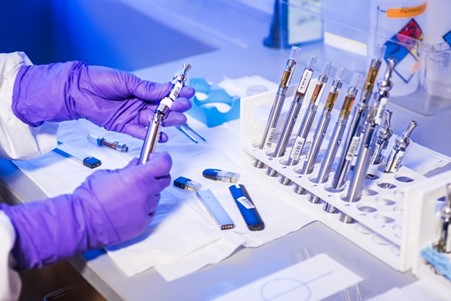Without fluoropolymers, many of today’s most innovative medical procedures would not be possible. Thanks to their durable, non-porous, yet smooth structure, they have made a significant impact on the healthcare industry. In the 90 years since their discovery, fluoropolymers have been used to coat medical devices and have played a vital role in the production of life-saving implants, tubes, and surgical tools.
In this post, we’ll explain why fluoropolymers make wonderful medical materials, and share some of the most common applications of fluoropolymer materials in the industry, such as heat shrink tubing. So, the next time you undergo a medical procedure, keep an eye out for fluoropolymers and you’ll likely find them all around.
The Essence of Fluoropolymers
Fluoropolymers are a type of polymer that contain fluorine atoms in their chain-like molecular structures. They are known for being strong, durable, and resistant to both heat and chemicals. Fluoropolymers were first discovered by accident in the 1930s and since then, they have been used in a variety of industries, including healthcare, automotive, and construction.
Odds are you probably own kitchenware made with fluoropolymers, i.e., polytetrafluoroethylene. This material is commonly sold under the name Teflon and is used to create non-stick pans, baking dishes, and spatulas. The healthcare industry uses the very same material to coat surgical instruments, as it allows them to slide in and out of the body with ease and reduces the risk of infection.
Unique Properties of Fluoropolymers
Fluoropolymers are prized within the medical industry for their unique properties, such as:
- Non-stickiness – Fluoropolymers do not interact with other substances, which makes them ideal for coatings and medical implants.
- Non-corrosiveness – Fluoropolymers are resistant to corrosion from both acid and alkali solutions.
- Non-reactivity – Fluoropolymers do not react with other substances, even when exposed to high temperatures or electricity.
For these reasons, nearly all hospitals rely on fluoropolymer tools and equipment.

Medical Uses for Fluoropolymers
Fluoropolymers have made a significant impact on the healthcare industry thanks to their unique properties. Medical grade fluoropolymers are now commonly used in the following ways:
- Coating surgical instruments – Fluoropolymers are commonly used to coat surgical instruments, as they create a smooth, non-porous surface that is easy to clean and helps to reduce the risk of infection. This is especially important in delicate procedures, such as eye surgery, where even the smallest amount of bacteria could cause serious complications.
- Creating implants and prosthetics – Fluoropolymers are also used to create implants and prosthetics, as they are strong and durable yet still flexible enough to move with the body. Joint replacement surgery, for example, commonly uses fluoropolymer materials.
- Producing tubes and catheters – Fluoropolymers are frequently used to produce tubes and catheters, as they are strong yet still flexible enough to navigate the body. They are also non-reactive, which is important when coming into contact with sensitive tissues.
Without these applications, many modern procedures would fail or come with a higher risk of infection.
Final Thoughts
Fluoropolymers have made a significant impact on the healthcare industry and have contributed to the development of many life-saving medical procedures. Thanks to their unique properties, they will likely continue to play an important role in the industry for many years to come.



